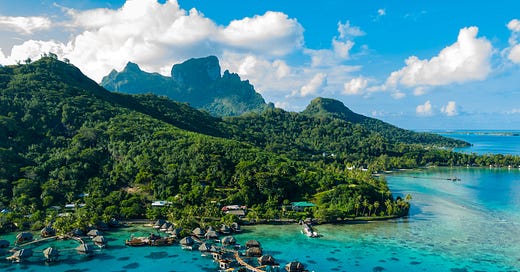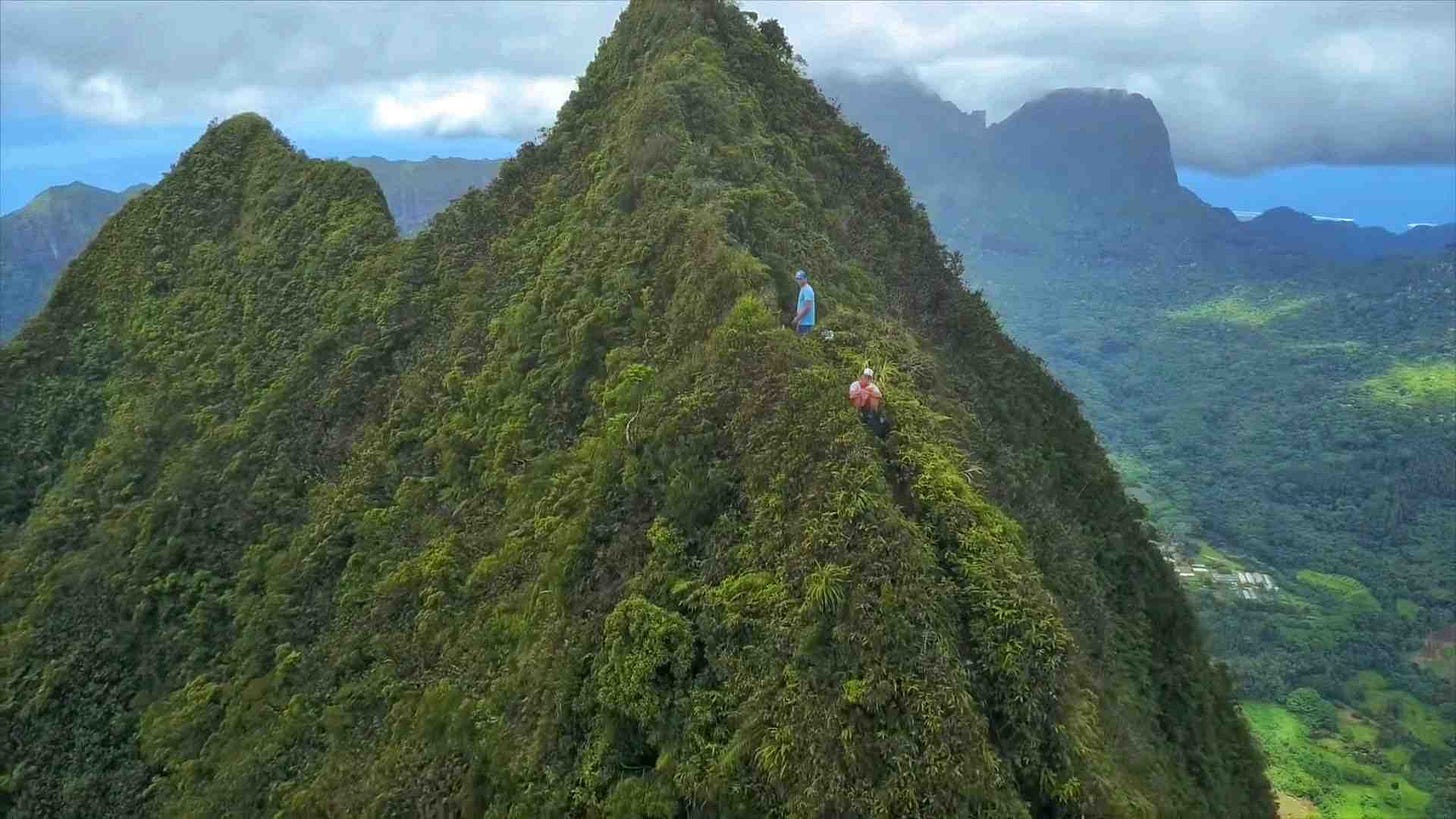Spot Check: French Polynesia
Moorea, Huahines and Tahiti… and a touch of Teahupoo (warning: content contains very little surfing)
[Editors Note: Where’s the best place you’ve been? It’s a question I’ve handled plenty of times with the same answer: Tahiti. And while Teahupo’o is in the news right now, with the Tahiti Pro kicking off tomorrow, and it hosting the Olympics in August, I figured enough has been written about the wave. This was from a press trip I did a while ago for The Independent, and is a more “straight” mainstream travel piece that covered a non-surfing trip tour to a few of the islands, staying in family-owned pensions. And it goes a little like this….
When my breath had slowed to a pant and my heart ceased racing, I wiped the sweat from my brow and looked out on an incredible sight. One thousand metres below, in a sea of mottled greens and coral lagoon blues, spread the island of Moorea. Further out, I could see other small French Polynesian isles popping out of the Pacific.
I had reached the highest point of the saddle between Moorea's peaks of Tohiea and Mouaroa after a three-hour "pineapple raid" – the local term for a mountain hike. The journey had started at what was definitively sea level: the white beach directly in front of the small family pension called Fare Edith where I was staying. A hike up to Le Belvedere led to a narrow trail over rich black soil, passing beside pineapple fields, through thick rainforest and onwards, up to my new, exalted position.
French Polynesia is one of those tropical island destinations, in an exclusive alphabet that starts with Antigua and ends with Zanzibar, that all travellers seem to find particularly seductive – even though the costs of getting there and staying there can be astronomical. However, there is a hack: lodging in local pensions is a good option and is likely to open doors to a culture and people that package holidays often neglect.
Fare Edith wasn't the cheapest on offer, but here a four-person air-conditioned bungalow with kitchen costs just £100 a night. Edith and her family took me in as one of their own – and the incredible surfing, diving and trekking made my stay all the more rewarding.
The Society Islands lie deep in the Southern Pacific Ocean, a cluster of extinct volcanoes lying about halfway between Australia and South America. This remoteness adds to the archipelago's allure, but the primary attraction lies in their beauty: warm blue waters contrasting with lush tropical landscapes.
Honeymooners come here, as do the ridiculously rich. I was neither, but the Tahiti tourism board was paying my way, and so straddled the nether regions. I divided my time between three atolls: Tahiti, Huahine and Moorea. After a few days on Moorea, I slipped effortlessly into Tahitian time, which entails following the lead of locals and spending hours on the very basics of life. Luckily in this part of the world, the bare necessities alone can make you very, very contented indeed.
After my pineapple raid and a much-needed swim, I was joined for dinner by my guide, Joel Hart. "I'm one-eighth German, one-eighth English, a quarter French, and half Tahitian,” he said. "My grandfather was an English aristocrat who was the first European to settle the Marquesas Islands, while my father became a successful property holder. I was his 16th child, at age 72, with his third wife."
Joel's family history is linked to that of French Polynesia as a whole. The islands have been populated by local Polynesians since about 300AD, but the spread of French Catholic missionaries in the early 19th century, and France's wish to protect them, saw it named first as a protectorate in 1842 and a colony half a century later. For Tahitians such as Joel, a Polynesian heritage and way of life has mingled with 200 years of French rule to produce a unique cultural blend.
"It's sometimes difficult to pinpoint who we are," said Joel. "We rely on the French government for economic survival and we've absorbed the French education and bureaucratic systems. And yet the Polynesian aspect of our heritage is fiercely independent."
Later, I shared a beer with two Australian surfers who raved about the cheap hostel and great waves up the road called Mark's Place, where the primary forms of transport on offer were hired bicycles and a kayak.
Meanwhile, Angela and Tristan, a couple in their late twenties from Ireland, had taken the Tahiti budget living lifestyle to a whole new level. They had a pitch at Nelson Camping, a rough and ready cabin and campsite based on (another) pretty white coral-protected beach a few kilometres away near the town of Haapiti. "As it was a fairly expensive flight, we thought we'd save on accommodation and put some of our money into the diving expedition and activities," Angela said. "It's 1,400 French Pacific francs [£10] a night to camp – and in a place like this, you want to be outdoors and in the ocean anyway."
A 30-minute plane ride took me to the more northerly island of Huahine, one of the least developed islands in French Polynesia. It's rarely visited by the honeymoon set, and the lack of resorts with the £600-a-night glass-bottomed huts means it has a raw, untouched feel to it. Here I stayed in Fare Maeva, another family-run pension perched on a secluded white sandy beach and coral-flecked lagoon.
I took the €75 island boat tour offered by Huahine Nautique, a boat operator located on the harbour's edge on the outskirts of the capital Fare. Huahine is so tiny that my all-day excursion circumnavigated the whole place. The highlight, though, was lunch. My boat driver Matai pulled into a pristine white sandy beach on a motu (an outlying sand island) that came complete with picnic tables secured in the water. In minutes he had filleted some white tuna, washed it in the sea, then marinated it with fresh lime and sea salt. He added coconut milk by passing freshly hacked coconut through a muslin sieve, then came some chopped tomato, cucumber and red onion.
As a final flourish, cold Hinano beers were produced and Matai accompanied my meal by twanging and twinkling expertly on his ukulele and singing traditional Polynesian songs. I ate it all with my feet dangling in the warm ocean – and it was easily the most enjoyable lunch I've ever had.
The next few days were spent exploring the island by land, first by Le Truck (the local bus) and then by moped. It was a chance to check out the remaining beaches and take a closer look at the thousand-year-old Ahu, the ceremonial stone placed at the centre of the marae. Then I was ready for the flight back to Papeete, the capital of Tahiti herself, and avoiding the (relatively) grubby port I rented a car and drove towards the town of Teahupoo, pronounced Cho-poo, and meaning "the end of the road", which is exactly where it is, about 100km from Papeete.
For centuries Teahupoo was a traditional fishing town, far removed from the Tahiti tourist brochures. However, once it was found to boast one of the best – and most dangerous – surfing waves in the world, it was thrust into the surfing limelight. The wave has created a window of opportunity for anyone owning a bed in the area; a host of pensions and homestays now operate in the village.
"It's nice to meet people from other places," said Papa Teava, the owner of Vaiani Pension, where I stayed. "And the surfers and visitors are usually very friendly. We treat them like family and open our home."
Papa Teava's house is perched on the water's edge; visitors can feed fish and rays from their bungalow balcony. It's cheap, too: an impressive €65 a night with breakfast and dinner included. You can hire skis, boats and drivers to get the five minutes to Chopes, or the other much more mellow waves nearby
My last day in Teahupoo summed up French Polynesia perfectly. Papa Teva invited me out for an afternoon's fishing, and after three hours we returned with some big tuna and mahi mahi. I helped Mama Teava clean and fillet the fish, then retired to the balcony to catch the epic sunset with a cold Hinano.
When that natural wonder burned itself out, I sat down with Papa and his family for our self-made feast. There were no waiters, no white tablecloths, and no fancy wines. But we were eating a fantastic meal in one of the most beautiful places on earth, with local people who had welcomed me into their home. It doesn’t get any better.








'author in foreground' - such a treat to catch a fleeting glimpse of Rod. Did not disappoint sartorially <3